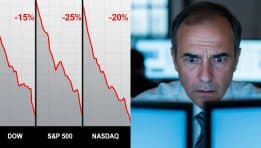Investor Sentiment: Analyzing Reactions to Kugler’s Resignation and the Dismissal of the BLS Commissioner
The recent resignation of Kugler and the subsequent firing of the BLS Commissioner have sent ripples through the investment community. These significant changes in leadership have raised eyebrows and prompted investors to reassess their positions and expectations regarding the market. It’s crucial to delve into how these events are influencing investor sentiment and what broader impacts may arise moving forward.
Initial reactions from investors have shown a mix of concern and cautious optimism. On one hand, the abrupt changes in leadership can foster uncertainty. Stability is a key component for investors, and any signal of inconsistency can lead to questions about organizational direction and strategy. When leaders are dismissed or resign unexpectedly, it often leads to speculation regarding the reasoning behind these decisions, which can stir emotions among investors and affect stock prices.
Yet, not all reactions are steeped in negativity. Some investors view leadership changes as an opportunity for a fresh approach. New leadership can mean new strategies, and a powerful shift in direction could potentially reinvigorate interest in a company or within the broader economy. Understanding these dual narratives is essential for navigating the complex landscape of investments during times of transition.
To analyze investor reactions effectively, several factors must be taken into consideration:
Market Trends: Changes in leadership often correlate with shifts in market conditions. Investors are keenly observing how these recent changes might affect market trends, especially in sectors that the BLS closely monitors.
Company Performance: When a significant figure such as the BLS Commissioner is dismissed, investors weigh potential impacts on company performance. Earnings reports, stock performance, and strategic initiatives could all be influenced by the new direction.
Future Outlook: Investors are constantly looking to the horizon. The potential for new leadership to bring innovative ideas and strategies could lead to a more favorable long-term outlook for the company.
Peer Reactions: How have other major players in the market responded? Monitoring competitor movements can provide insights into broader industry sentiments and potential shifts in market dynamics.
The impact on investor sentiment can be evident through shifts in stock prices once such news breaks. Volatility often increases during periods of uncertainty, and traders may act reflexively based on rumors or speculative information, further intensifying fluctuations. This creates an environment where patience and strategic thinking are essential for investors to make well-informed decisions.
As the dust settles following Kugler’s resignation and the dismissal of the BLS Commissioner, more data will emerge. Analysts will likely scrutinize the consequences of these changes on economic policy and performance metrics. Investors need to stay informed, as the relationships between leadership changes, economic indicators, and market value become clearer.
In the days ahead, one of the big questions investors are considering is: What does this mean for macroeconomic policy? With new leadership often comes new policies. Investors will closely monitor any adjustments that could be implemented by the new BLS leadership as they could significantly impact the economic environment. Will they continue on the existing path, or will they introduce transformative measures that could change the landscape? These are essential considerations that investors must explore as they think about their next moves.
It’s also worth noting the role of public perception in shaping investor sentiment. The media plays a substantial part in informing market participants and shaping narratives around leadership changes. Investors should be critical consumers of information, looking beyond headlines to understand the deeper implications of leadership transitions.
Ultimately, while Kugler’s resignation and the dismissal of the BLS Commissioner bring uncertainty, they also provide a canvas for new opportunities. Investors who can navigate this changing terrain thoughtfully will be well-positioned to capitalize on potential gains that could emerge from these leadership shifts. Keeping a close eye on market behavior, public sentiment, and performance metrics will be key to making informed investment decisions in this transformative era.
The Impact of Leadership Changes on Market Trends and Investor Confidence
In today’s fast-paced financial markets, changes in leadership can have a significant ripple effect on investor confidence and market trends. When key figures in financial institutions, corporations, or regulatory bodies resign or are fired, the reactions from investors can be immediate and telling. Understanding this dynamic is crucial for anyone looking to navigate the complex landscape of investments.
When a leader is removed, it creates uncertainty. Investors often fear that such a decision indicates underlying problems within the organization. This fear leads to decreased confidence, which can result in stock prices dropping sharply as investors rush to sell before potential losses deepen. The recent resignation of a prominent business leader, for example, can trigger a wave of speculation among traders and analysts about the firm’s future prospects.
Generally, there are a few key areas where leadership changes can directly impact investor sentiment:
Market Volatility: Sudden leadership changes increase market volatility. With uncertainty in the air, traders may react impulsively, leading to price swings. For instance, when KUGLER announced his resignation, analysts noted a spike in trading activity as investors attempted to gauge the implications of this shift.
Shifts in Strategy: A new leader often brings a new strategy. This can cause ripples in the market if investors are unsure how these changes will impact long-term value. It’s essential for investors to keep a close watch on any strategic shifts and assess if they align with their investment goals.
Impact on Employee Morale: Leadership changes can affect employee morale, which in turn can impact productivity and innovation. If employees are uncertain about their futures following a leadership overhaul, it may lead to a decline in performance, which can be reflected in company earnings reports and investor sentiment.
Investor Relations: Establishing trust is crucial. New leaders typically need to work on rebuilding investor relations, especially if the change was unexpected. Communication and transparency are key, as investors want reassurance about company direction and stability.
Investor reactions are often influenced by the circumstances surrounding a leadership change. If a resignation appears to be the result of poor performance or a scandal, investors may react negatively. Conversely, if the change is perceived positively, such as bringing in a visionary leader or a necessary overhaul of outdated practices, investors may respond favorably and even increase their stock holdings.
The broader economic context also plays a role in how investors react to leadership changes. For instance, during times of economic instability, any leadership resignation can be amplified in its impact, as investors are on high alert for any signs of weakness. In these tenuous circumstances, leaders are often expected to show a steady hand and provide reassurance about future plans.
It’s important to note that while leadership changes often spark immediate reactions, the long-term impacts can vary widely. Research shows that companies with proactive management strategies can recover and thrive after a leadership change, particularly when the new leader initiates transformative changes that address previous shortcomings. These successful transitions are essential for rebuilding investor trust and restoring market confidence.
For investors, staying informed is crucial during these leadership transitions. Monitoring company communications, leadership profiles, and industry reports can provide invaluable insights into how these changes are likely to affect the market. Also, looking at similar past events can offer a roadmap for predicting potential outcomes.
Investors would do well to consider engaging in more fundamental analysis during periods of leadership transition. This involves not only looking at financial metrics but also understanding the industry environment, competitive pressures, and regulatory factors that may come into play with new leadership.
Leadership changes can significantly impact market trends and investor confidence. The reactions from investors are shaped by the immediate circumstances of the change, the broader economic environment, and the projections for future company performance. For anyone involved in investing, recognizing these dynamics is essential in making informed decisions and navigating potential opportunities or risks in a constantly evolving marketplace.
Conclusion
As the dust settles on Kugler’s resignation and the firing of the BLS Commissioner, investors are left grappling with the implications of these significant leadership changes. The immediate reactions from the investment community highlight a mix of uncertainty and cautious optimism. For many investors, effective leadership is paramount in fostering an environment conducive to growth and stability. When key figures like Kugler step down or are dismissed, the ripples can impact market trends, shaking the confidence that many hold in the current administration’s economic policies.
The connection between leadership and investor sentiment cannot be underestimated. Investors are vigilant about how these changes may alter the course of economic indicators and overall market performance. Uncertainty tends to breed volatility, as traders adjust their strategies in response to potential shifts in policy and direction. This response often reveals a nuanced understanding of the larger economic landscape. Thus, as these leadership transitions take place, it’s vital for investors to remain informed, engage with multi-faceted market analyses, and stay tuned to any shifts in policy that could reflect on their investments.
Ultimately, adapting to change is key for any investor. As new leadership settles in, maintaining a keen eye on how these changes influence broader economic conditions will be essential for strategic investing. Engaging with market trends, understanding the nuances of leadership impact, and remaining flexible in one’s investment strategies will help navigate this evolving scenario. Times of change can often present opportunities for those ready to seize them.
Comparison, examination, and analysis between investment houses
Leave your details, and an expert from our team will get back to you as soon as possible
* This article, in whole or in part, does not contain any promise of investment returns, nor does it constitute professional advice to make investments in any particular field.
To read more about the full disclaimer, click here- Articles
- •
- 18 Min Read
- •
- ago 31 minutes
 STOCKS CLOSE LOWER AFTER TRUMP’S NEW TARIFFS, WEAK JOBS REPORT
STOCKS CLOSE LOWER AFTER TRUMP’S NEW TARIFFS, WEAK JOBS REPORT
The Impact of Trump's New Tariffs on Stock Market Performance and Economic Stability In recent times, markets have felt the
- ago 31 minutes
- •
- 18 Min Read
The Impact of Trump's New Tariffs on Stock Market Performance and Economic Stability In recent times, markets have felt the
- Articles
- •
- 18 Min Read
- •
- ago 1 hour
 COINBASE SHOWS HUGE UNUSUAL OPTIONS VOLUME AFTER LOWER RESULTS
COINBASE SHOWS HUGE UNUSUAL OPTIONS VOLUME AFTER LOWER RESULTS
Analyzing the Impact of Unusual Options Volume on Coinbase After Lower Financial Results After a recent announcement of lower financial
- ago 1 hour
- •
- 18 Min Read
Analyzing the Impact of Unusual Options Volume on Coinbase After Lower Financial Results After a recent announcement of lower financial
- Arik Arkadi Sluzki
- •
- 14 Min Read
- •
- ago 1 hour
 The TACO trade won’t save the market from Trump’s latest tariff blitz
The TACO trade won’t save the market from Trump’s latest tariff blitz
Analyzing the Impact of Trump's Latest Tariff Blitz on the TACO Trade The recent implementation of additional tariffs by the
- ago 1 hour
- •
- 14 Min Read
Analyzing the Impact of Trump's Latest Tariff Blitz on the TACO Trade The recent implementation of additional tariffs by the
- Arik Arkadi Sluzki
- •
- 18 Min Read
- •
- ago 1 hour
 STOCK MARKET TODAY: DOW, S&P 500, NASDAQ TANK AS MARKET CONFIDENCE CRACKS UNDER TRUMP TARIFFS, WEAK JOBS DATA
STOCK MARKET TODAY: DOW, S&P 500, NASDAQ TANK AS MARKET CONFIDENCE CRACKS UNDER TRUMP TARIFFS, WEAK JOBS DATA
The Impact of Trump's Tariffs on the Stock Market: Analyzing the DOW, S&P 500, and NASDAQ Declines The recent turmoil
- ago 1 hour
- •
- 18 Min Read
The Impact of Trump's Tariffs on the Stock Market: Analyzing the DOW, S&P 500, and NASDAQ Declines The recent turmoil












